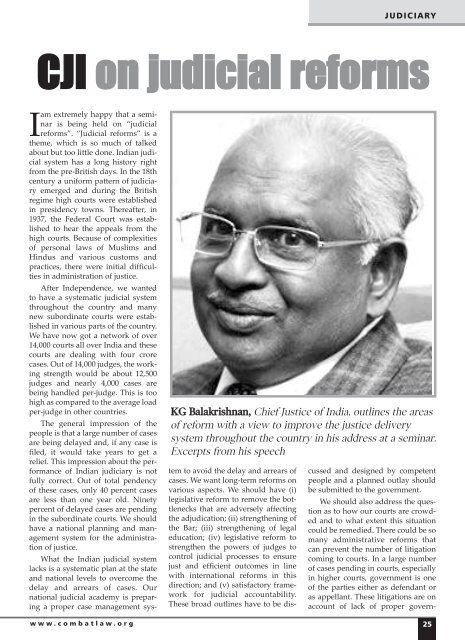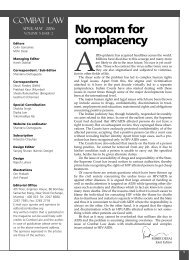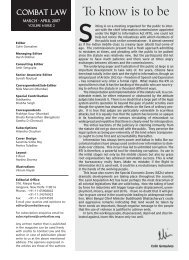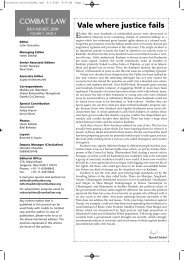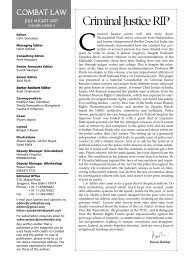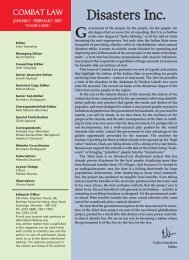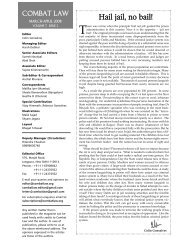Download (PDF, 122KB) - Combat Law
Download (PDF, 122KB) - Combat Law
Download (PDF, 122KB) - Combat Law
Create successful ePaper yourself
Turn your PDF publications into a flip-book with our unique Google optimized e-Paper software.
1general:general.qxd 5/28/2008 5:18 PM Page 25<br />
JUDICIARY<br />
CJI on judicial reforms<br />
w w w . c o m b a t l a w . o r g<br />
KG Balakrishnan, Chief Justice of India, outlines the areas<br />
of reform with a view to improve the justice delivery<br />
system throughout the country in his address at a seminar.<br />
Excerpts from his speech<br />
Iam extremely happy that a seminar<br />
is being held on “judicial<br />
reforms”. “Judicial reforms” is a<br />
theme, which is so much of talked<br />
about but too little done. Indian judicial<br />
system has a long history right<br />
from the pre-British days. In the 18th<br />
century a uniform pattern of judiciary<br />
emerged and during the British<br />
regime high courts were established<br />
in presidency towns. Thereafter, in<br />
1937, the Federal Court was established<br />
to hear the appeals from the<br />
high courts. Because of complexities<br />
of personal laws of Muslims and<br />
Hindus and various customs and<br />
practices, there were initial difficulties<br />
in administration of justice.<br />
After Independence, we wanted<br />
to have a systematic judicial system<br />
throughout the country and many<br />
new subordinate courts were established<br />
in various parts of the country.<br />
We have now got a network of over<br />
14,000 courts all over India and these<br />
courts are dealing with four crore<br />
cases. Out of 14,000 judges, the working<br />
strength would be about 12,500<br />
judges and nearly 4,000 cases are<br />
being handled per-judge. This is too<br />
high as compared to the average load<br />
per-judge in other countries.<br />
The general impression of the<br />
people is that a large number of cases<br />
are being delayed and, if any case is<br />
filed, it would take years to get a<br />
relief. This impression about the performance<br />
of Indian judiciary is not<br />
fully correct. Out of total pendency<br />
of these cases, only 40 percent cases<br />
are less than one year old. Ninety<br />
percent of delayed cases are pending<br />
in the subordinate courts. We should<br />
have a national planning and management<br />
system for the administration<br />
of justice.<br />
What the Indian judicial system<br />
lacks is a systematic plan at the state<br />
and national levels to overcome the<br />
delay and arrears of cases. Our<br />
national judicial academy is preparing<br />
a proper case management system<br />
to avoid the delay and arrears of<br />
cases. We want long-term reforms on<br />
various aspects. We should have (i)<br />
legislative reform to remove the bottlenecks<br />
that are adversely affecting<br />
the adjudication; (ii) strengthening of<br />
the Bar; (iii) strengthening of legal<br />
education; (iv) legislative reform to<br />
strengthen the powers of judges to<br />
control judicial processes to ensure<br />
just and efficient outcomes in line<br />
with international reforms in this<br />
direction; and (v) satisfactory framework<br />
for judicial accountability.<br />
These broad outlines have to be discussed<br />
and designed by competent<br />
people and a planned outlay should<br />
be submitted to the government.<br />
We should also address the question<br />
as to how our courts are crowded<br />
and to what extent this situation<br />
could be remedied. There could be so<br />
many administrative reforms that<br />
can prevent the number of litigation<br />
coming to courts. In a large number<br />
of cases pending in courts, especially<br />
in higher courts, government is one<br />
of the parties either as defendant or<br />
as appellant. These litigations are on<br />
account of lack of proper govern-<br />
25
1general:general.qxd 5/28/2008 5:18 PM Page 26<br />
JUDICIARY<br />
mental administration. If the decision-making<br />
authorities take firm,<br />
independent and impartial decisions,<br />
the citizens would not normally be<br />
driven to litigations. Lack of proper<br />
and good governance largely contributes<br />
to the number of cases in<br />
subordinate courts. For example,<br />
weak and inefficient revenue administration,<br />
which results in poor land<br />
rights recording system is the main<br />
reason for large number of civil litigations.<br />
If the revenue administration<br />
is streamlined and every one in<br />
this country is given proper title<br />
deeds with computerised diagrams,<br />
a large number of land disputes<br />
could be avoided.<br />
In states where the revenue<br />
administration is poor, there are<br />
large number of civil cases and these<br />
disputes relate either to title or<br />
boundaries of their properties and<br />
these cases could be avoided, if proper<br />
re-survey operations are done and<br />
proper revenue records are maintained<br />
by the authorities.<br />
Now, a large number of financial<br />
institutions are trying to recover<br />
money through criminal proceedings<br />
by making use of the provisions of<br />
the Negotiable Instruments Act. The<br />
courts have become the collecting<br />
agents for these financial institutions.<br />
Most of them are privately owned by<br />
people who engage in the practice of<br />
giving usurious loans. Because of<br />
these types of cases, trial of ordinary<br />
criminal cases is seriously hampered.<br />
A large number of motor accident<br />
claims are pending in various<br />
Tribunals. In some states, it takes<br />
more than four/five years to settle the<br />
claim despite the fact that large number<br />
of cases are settled through Lok<br />
Adalats. The insurance companies<br />
should have proper settlement methods<br />
whereby they must acknowledge<br />
their liability and disburse the<br />
amount to the claimants even before<br />
they come to courts. Such a streamlined<br />
procedure is not available in<br />
our system. When the claimants are<br />
before the courts, the insurance companies<br />
are not in a position to settle<br />
the claims even in cases where they<br />
admit their liability. Considering the<br />
large number of cases pending in<br />
various courts, it is better that we<br />
should have a “structured formula”<br />
whereby insurance companies can<br />
pay the amount and those who are<br />
dissatisfied with the settlement can<br />
approach the tribunal for enhancement.<br />
This is also the situation in<br />
respect of land acquisition cases. The<br />
amount awarded by the land acquisition<br />
officer has never been reasonable<br />
or proper. The parties are driven<br />
to litigation in large number of cases.<br />
At the district level, if there is a district-wise<br />
high power committee to<br />
fix the compensation at a reasonably<br />
good amount, most of the claimants<br />
may accept it and only very few<br />
would resort to file land azcquisition<br />
cases for enhancement.<br />
As regards criminal cases, there<br />
are other contributory factors which<br />
cause large pendency of cases. In<br />
some of the cases, the investigation is<br />
tardy and inefficient and takes long<br />
time to file the final report. Even after<br />
we have achieved advancement in<br />
science and technology, the fruits of<br />
such scientific developments are not<br />
being tapped by the police to have<br />
investigation in a scientific manner.<br />
We do not have enough scientific laboratories<br />
and many a time the report<br />
of the forensic laboratory is delayed<br />
inordinately. Inept policing and<br />
weak prosecution are hugely responsible<br />
for slowing down and protracting<br />
the criminal trial in many courts.<br />
We are trying to have a planned<br />
approach to delay and arrears reduction.<br />
We are trying to have national<br />
minimum court performance standards<br />
that will set the minimum that<br />
the people of India can expect from<br />
the subordinate courts. We propose<br />
to have the following elements:<br />
(i) Disposal level of the national system<br />
should be raised from 60 percent<br />
of total case load (as of now)<br />
to 95-100 percent of total case<br />
load in five years. This will<br />
require this target to be established<br />
at the court, district, state<br />
levels as well.<br />
(ii) Each court to ensure that not<br />
more than five percent of the<br />
cases in that court should be more<br />
than five years old (5x5 rule)<br />
within the next three years; and in<br />
five years to ensure that not more<br />
than one percent of the cases<br />
should be more than one years<br />
old (1x1 rule).<br />
(iii) Timetables to be established for<br />
every contested case and monitored<br />
through a computerised<br />
signalling system (NJA has developed<br />
and piloted a model).<br />
(iv) Case numbers to indicate “litigation<br />
start dates” prominently in<br />
addition to filing dates.<br />
(v) Use of ADR for civil cases and<br />
plea bargaining for criminal cases<br />
to be enhanced and monitored<br />
through a nation-wide computerised<br />
tracking system.<br />
(vi) Bottleneck monitoring: Four key<br />
bottlenecks causing delays in civil<br />
and criminal process to be monitored<br />
through a computerised<br />
system and special attention to be<br />
provided through a special cell at<br />
the high court and district level to<br />
resolve issues in coordination<br />
with executive agencies: (a) service<br />
of process; (b) adjournments;<br />
(c) interlocutory orders; and (d)<br />
appearance of witnesses and<br />
accused.<br />
We are also thinking of having<br />
common minimum human resources<br />
management standards and also<br />
common minimum judicial infrastructure<br />
standards. Our national judicial<br />
academy is imparting training to<br />
judicial officers and we have successfully<br />
completed about 12 judicial<br />
training programmes last year. I, once<br />
again, express my gratitude to the<br />
Confederation of Indian Bar for having<br />
organised this seminar. We would<br />
like to have the views of all the eminent<br />
personalities who participated<br />
in this seminar and the ideas that<br />
would emerge from this discussion<br />
would be seriously considered and<br />
any suggestion made by the participants<br />
which is worthy of implementation<br />
would be seriously considered,<br />
pursued and implemented. I beseech<br />
the co-operation of the Bar for a better<br />
administration f justice.<br />
– The CJI delivered this speech in a<br />
seminar held on February 23 & 24,<br />
2008 in New Delhi<br />
26<br />
C O M B A T L A W M A Y - J U N E 2 0 0 8


